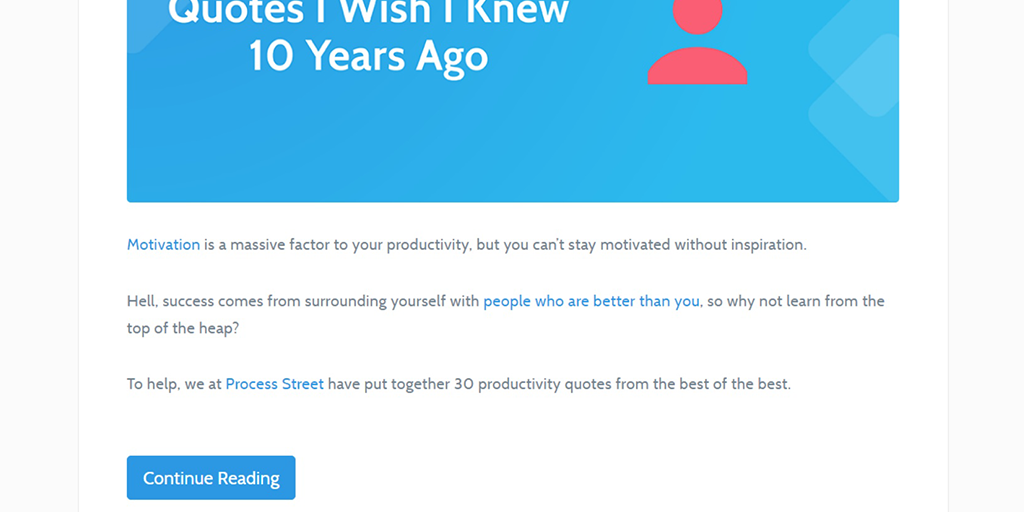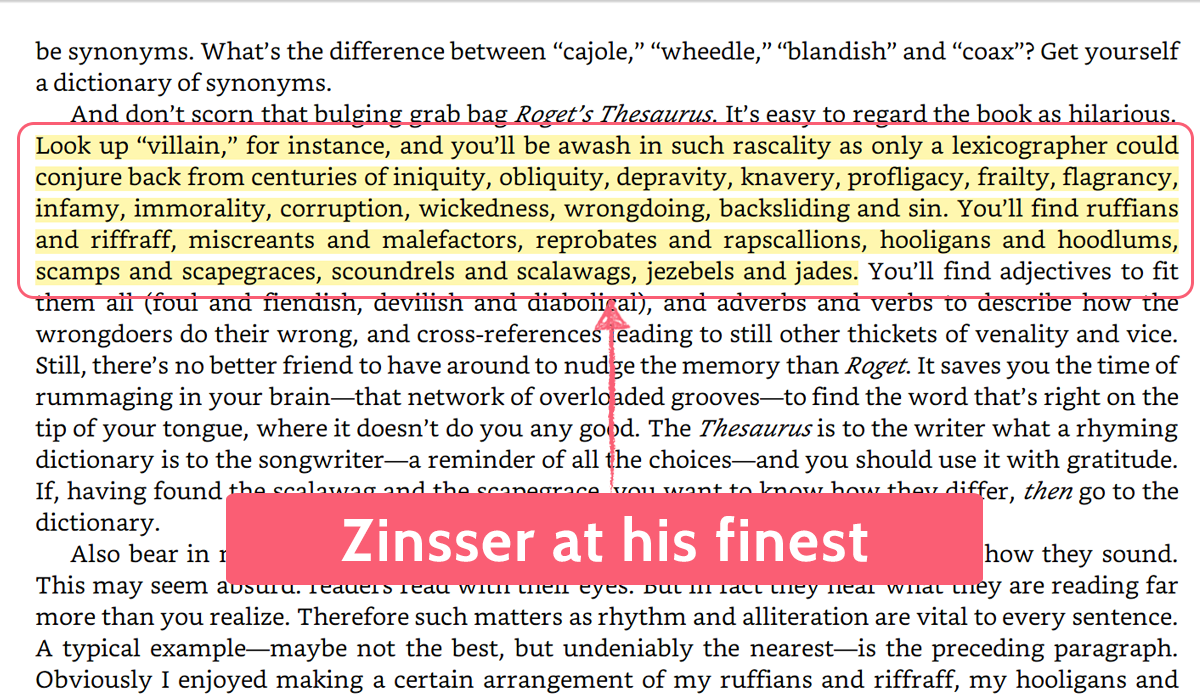
If you think your writing’s any good, this book will cut you down to size…
I used to think that I could write well enough…
See William.
See William run.
See William write a 300-page book which taught me how to correct the mistakes I never knew I was making.
That’s what this book is; a display of how bad both you and I are at writing. As such, this On Writing Well review is as much to show the key points to William Zinsser’s thoughts as it is a review of the past year of my own work here at Process Street.
Here’s to improving our writing and avoiding common content writing mistakes, all whilst making an ass of myself.
After all, it’s hard enough to build a blog when your writing game is on point, let alone when you’re making mistakes that are next to impossible to spot on your own.
By taking Zinsser’s lessons on writing well, I’m going to assess my own method for:
- Making a good lead
- Stripping all clutter
- Finding the humanity in writing
- Having a smooth flow
- Checking the sound of my writing
- Surprising the reader
And now, the main event.
A good “lead” is vital
The “lead” is the time it takes for the reader to be hooked, and in this age of on-demand entertainment and social media, it needs to be priority number one.
The reader’s eye must be caught and kept hostage until the end of the piece – it’s not good providing value later on if 32% of your audience has left before the 150 word mark. As Zinsser puts it;
“Your lead must capture the reader immediately and force him to keep reading. It must cajole him with freshness, or novelty, or paradox, or humor, or surprise, or with an unusual idea, or an interesting fact, or a question. Anything will do, as long as it nudges his curiosity and tugs at his sleeve.”
There isn’t a set length for leads, but for articles like this one the reader should be hooked before your “more” tag – that is, the preview of the post on the blog’s main page.
So, for this step, you need to focus on writing better headlines, getting better featured images, and making high quality introductions.
To show this in action, let’s compare my last article with that of a far better copywriter; Brian Dean.

My productivity quotes article has a mediocre lead, at best. A bland statement linking productivity to motivation, a tie back to the quotes to follow, and an unnecessary article link – how does surrounding yourself with successful people relate to productivity quotes?
It doesn’t.
The only redeeming elements of this lead are its brevity and slight hints towards humanity in the second sentence.

Brian Dean’s lead is far more effective.
“Today I’m going to show you a new strategy that boosted my organic traffic by 260.7%”
Wow, how long did that take?
“(In 14 days)”
Fantastic, but what about social content?
“This strategy also led to a flood of visitors from Twitter, Facebook and blogs.”
Sounds too good to be true – I don’t want to flood my blog with extra content for a brief spike in traffic.
“The best part? I didn’t need to publish any new content.”
I’m sold.
Strip the clutter
While it’s tempting to show off with big words and complex language, the first step to writing well is cutting the clutter. This means removing:
- Words that serve no purpose (filler words)
- Most adjectives
- Most adverbs
- Long words (if they can be replaced with short ones)
It’s not easy – my old History papers swam with fluff I felt gave weight to the facts – but it’s satisfying. Stripping clutter improves your content quickly, leaving you with a condensed article which has power behind the prose.
Take the first paragraph of my article on how to improve productivity, for example.
“Two weeks ago I had a brainstorm with my team to think of how to improve productivity; the 4 ideas we came up with increased my output by 375% and ensured that I no longer resort to 70 hour work weeks. Obviously, this was just too good to keep to the Process Street team alone, so stick around if you want to find out how I did it!”
- The time scale is important to show how fast these tips work, so that stays.
- “Brainstorm” means nothing and is practically a cliche – drop it.
- The percentage stands out and is a good show of the article’s value
- “70 hour work week” can be dropped or relocated – two value statements in the same sentence is distracting.
- The last sentence serves no purpose – if you need to tell them to keep reading, you’ve already failed.
So we’re left with:
“I recently increased my productivity by 375%.
How recently? Over the last two weeks.
You can do the same using these four free and easy ideas.”
It still needs tweaking and putting in context, but if I’d done this in the first place my page-long introduction wouldn’t be there.
Find the humanity
Whether you’re writing about business process automation or the ultimate Sunday, the reader should always be able to find humanity in your writing. If your piece reads as if it was spat out by an emotionless husk, no-one will stick around.
There are three ways to do this. First, you can put the article in a context they understand. Nobody relates to Zapier vs IFTTT, but the lead starts with a jab at Hawaiian pizza, making a tech review into a rivalry.

Second, you can find the humans in your topic and bring them to the fore. Blogging tips from the ether hold no weight, but back it up with examples from the masters and you have yourself a case study.
Take this very On Writing Well review, for example – just reviewing the book serves little to no purpose, but tearing myself a new one while doing so gives it more draw.
The final (and easiest) way to bring humanity to your piece is to write with enthusiasm. Yes, it sounds corny, but I guarantee that your reader will notice the difference between an article you blasted out on the back of a great idea, and one you slogged out to say “we have new content”.
Enthusiasm brings out the best in writers – not only do your articles form faster, but your writing flows naturally from topic to topic. You’ll still need to cut and rewrite a lot, considering enthusiasm can lead to getting carried away, but the finished product will still benefit greatly.
Check your flow
If the reader stalls or loses interest then the writer’s flow wasn’t good enough to get them to the next sentence. One point must feed into another, one sentence into the next, from the lead until the close.
My flow used to be very academic – I was writing in the style of essays more concerned with facts and arguments than being interesting or easy to read. The content was interesting (if too flowery) but the standard block-paragraph flow made it nigh-impossible to be enthusiastic.
It was only after reading William Zinsser that the message truly stuck with me.
To that end, shorten any sentences you can. Writing more than is needed to make a point dilutes your argument with unnecessary fluff.
However, don’t write only short sentences.
You need to be able to make your point before the end of a sentence or paragraph.
Otherwise your article (and argument) turns into a disjointed, ugly mess.
After a while the reader just stops putting your points together and everything loses meaning.
Like right now.
Long sentences and paragraphs have their place, but balance them between shorter segments, along with images, bullet points, headings, quotes, etc. Doing so makes the piece interesting to the eye rather than just the mind.
The best way I’ve found to help with this is to treat your writing flow as an extension of your regular workflow management. Spend too long doing the same thing and you’ll only drive yourself crazy – variety needs to be plentiful if you want to keep the interest of both yourself and the reader.
Know the sound of your writing
Words are not just read – they are spoken internally in the reader’s voice. Go ahead, try and read this sentence without hearing a voice narrating it.
It’s impossible.
As such, if a writer doesn’t account for the sound of their writing, they won’t keep their audience for long. You need to be aware of the rhythm of your sentences and the appeal of your wording.

A good writer is part poet, and I fully admit that I’m lacking in this aspect. I know the sound of my writing (I’m speaking this sentence aloud as I type), but I am still inexperienced in rhythm. My arguments are sound and clutter rounded up, but ringmaster I am not.
However, this is a great way to start training – by reading aloud. Read your article to a friend and see if they wince. Hell, read your article to yourself and make note of the stutters – these are your starting points.
Surprise the reader
The final tip I picked up when doing this On Writing Well review is to entertain the reader by surprising them. Whether it’s by using humor or choosing unusual (yet fitting) words, if your work is surprising, it’s both more interesting and memorable.
Unknowingly, I’d already started doing this long ago. I’ve always tried to inject a bit of humor into my articles, mainly for my own enjoyment, but it turns out I was onto something.
Don’t be afraid of cracking a joke, or worrying whether your audience will “get it”. If you make even one person chuckle then you’ve succeeded – if not, it’ll be skimmed over and forgotten, with no loss either way.
Dictionaries are another great source for surprising the reader, purely through your choice of words. Never stop searching for synonyms, and if you don’t know the subtle differences between “cajole” and “coax”, look them up.
Above all else, avoid cliches like the plague.
They are the death of expectation, the sign of a writer who’s satisfied repeating what others have written a thousand-fold before them.

Never be satisfied with the humdrum of common knowledge. Writing, like any other craft, takes care and practice to perform well – without that care and individuality your hand carved piece of art is reduced to naught but an IKEA cabinet.
Have any words of wisdom to add to this On Writing Well review? Got your very own productivity system for your writing? I’d love to hear from you in the comments below.







Ben Mulholland
Ben Mulholland is an Editor at Process Street, and winds down with a casual article or two on Mulholland Writing. Find him on Twitter here.